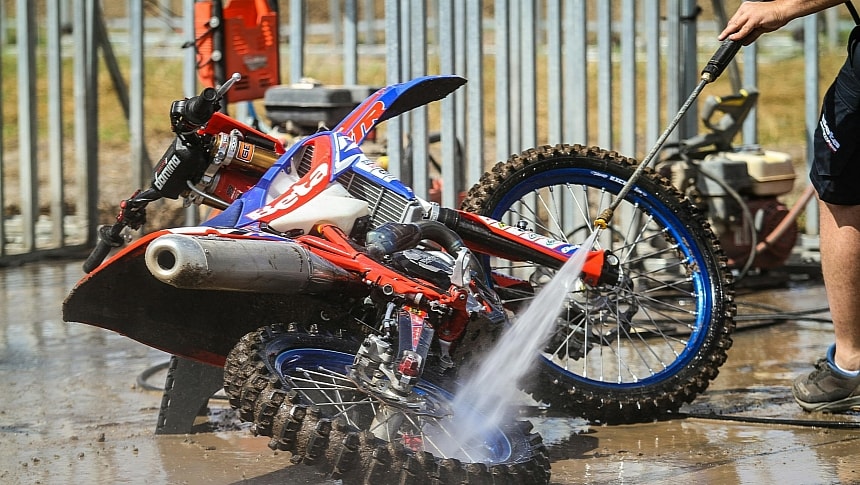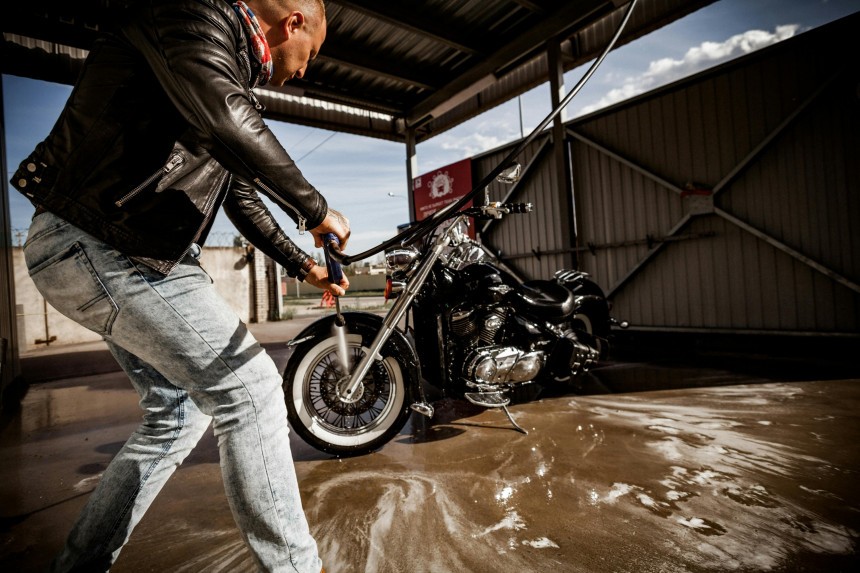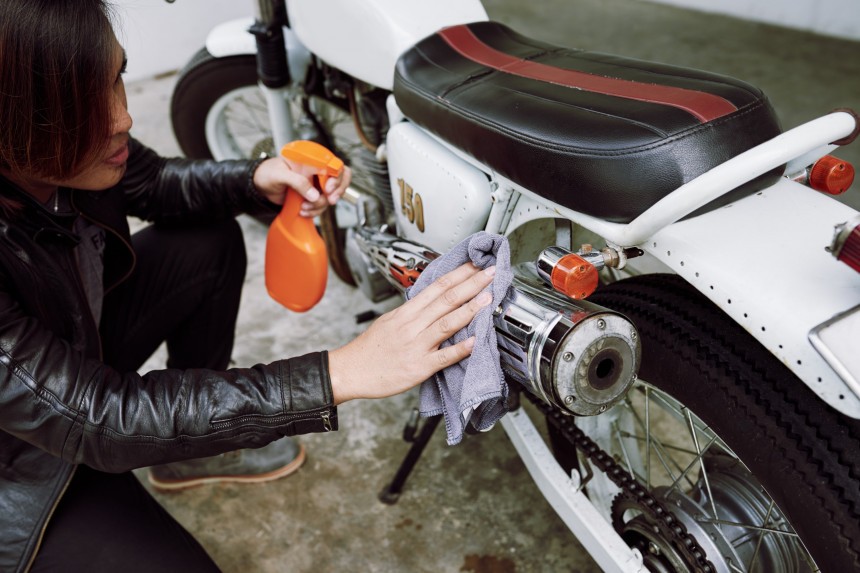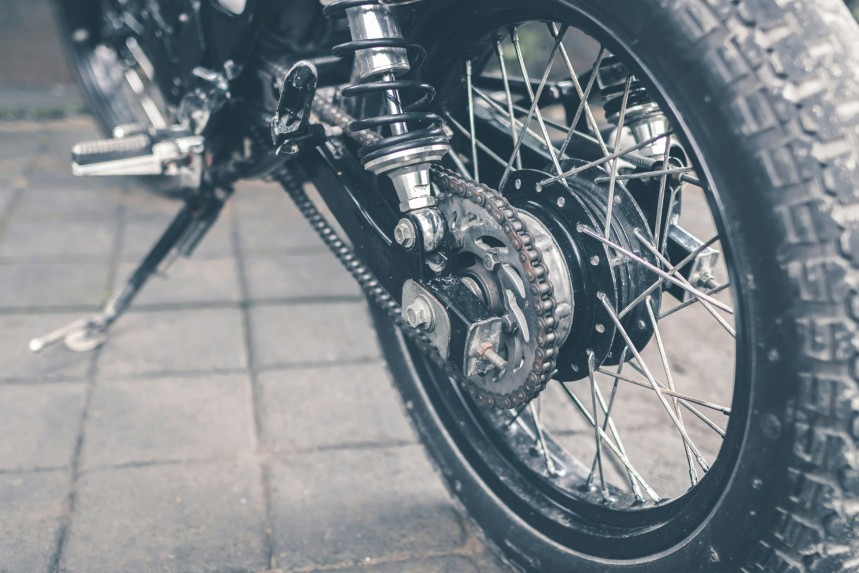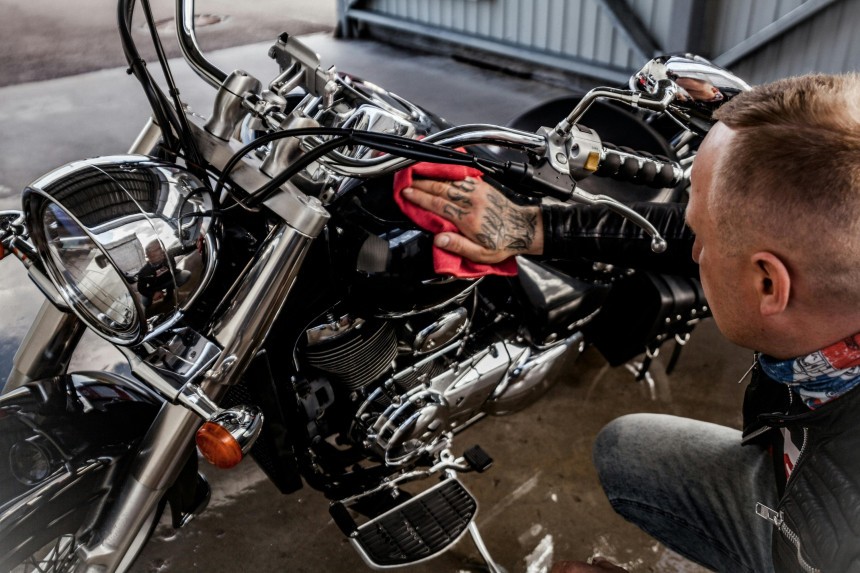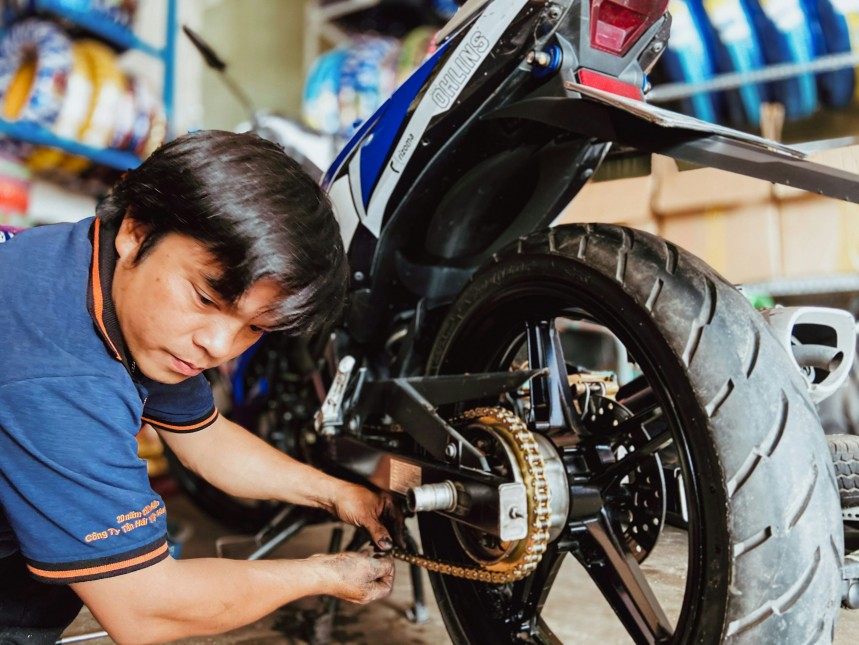Old dogs know how to take care of their rides properly, but newer riders may be tempted to overdo a bit in certain directions. Even though some might say that washing a motorcycle is a very simple task (and it is), people make certain errors that may damage their two-wheelers.
While the present guide does not aim to become some sort of bike-washing bible, we thought that a quick rundown of the most common mistakes and how to avoid damaging your ride would be a good, informative read regardless of your riding experience. So, here we go!
Well, how about hardening? Metal hardening procedures follow certain rules closely in terms of initial temperature, cool-down, and so on. Hardening or tempering metal parts is a science-based industrial process, unlike washing a bike. The reactions that take place during the hardening process have nothing to do with the most unscientific way you douse your hot engine in cold water.
In extreme cases, engine blocks may crack, or their finish may suffer. The same goes for the hot pipes, and acting too hastily may damage the chrome or nickel coating.
The only acceptable situation when you can wash your bike straight after you ride is if you have an all-electric two-wheeler. There's no need to let things cool down, as temperature levels are much lower than on an ICE bike.
DO wait a bit before you spray cold water on your bike. Several minutes won't make a big difference in your day's schedule, but they can help you stay out of trouble.
Why? Soap and sun don't mix well. The soap will dry too quickly if you keep the bike under the sun and will leave marks and streaks.
So, it's best to lean your motorcycle in the garage, under a canopy, or basically anywhere where you'll have shade for the entire duration of the cleaning process.
You probably know that prolonged exposure to sunlight can have negative effects. Paint and plastic parts fade, rubber parts deteriorate, electrical components can suffer damage, and the risk of your bike overheating increases. So, after you're done admiring your shiny bike, park it in a shaded area or use a cover to protect it from direct sunlight.
It's way more comfortable to have everything you need at hand so you can get the job done in one step. Getting the things you need will not cost you a fortune, especially because you'll use these objects more than once. Stocking up on good products for numerous at-home washes will be much cheaper than paying someone to wash your bike.
First, make sure you have a water supply and a hose. Next, we have washing products. You should invest in high-quality motorcycle cleaners designed specifically to remove grease and tough dirt. Look for a product that's safe to use on a variety of surfaces, including chrome, plastic, and paint.
Please don't use car shampoos or household detergents, as they might contain harsh chemicals that could damage your bike's paint job.
A degreaser is also important for cleaning your two-wheeler's engine and other greasy parts. Again, look for one that's safe for motorcycles. A leather conditioner is another great product to use if you have leather on your bike.
Brushes are useful for scrubbing dirt and grime from your motorcycle. Make sure to get a soft-bristle one so as not to scratch the paint. Finally, a microfiber cloth is another essential, perfect for drying and polishing your bike.
Be realistic about how long it'll take you to wash your motorcycle. If you are just looking forward to cleaning the thick layer of mud off your dirt bike, this can be done in several minutes, but if you feel like restoring your chromed-up cruiser as close as possible to its dealership condition, this will take more than half an hour, so make sure your agenda allows it.
DO take the time to check if you need anything before starting to clean your ride.
DO inspect your motorcycle for any damages before cleaning it. DO address the issues before washing to prevent further damage.
As cleaning a bike's chain is a really dirty job, it only makes sense that you do this before you get to clean the rest of the bike, doesn't it? Using special chain cleaning products and brushes has good odds of getting dirt occasionally sprayed on other parts, but once the chain is clean, it will be much easier to spot the areas that need extra attention from you.
DO use products specially designed for chain care, as traditional shampoos and similar household items just won't do. And DO use a hand-cleaning cream that will leave the tiniest crack in your skin squeaky clean. It doesn't make sense to wash a bike with grimy hands. Finally, DO make sure to lubricate the chain after you're done cleaning it to prepare it for your next ride.
In case you didn't know, the manufacturers have inserted special rubber grommets between the metal links that make up a chain. You've most likely heard about Z-rings, O-rings, or X-rings. Well, these letters are inspired by how the cross-section of a grommet looks.
What is more important than their looks or names is what these rubber rings do. When the chain is assembled, the bolts that keep links together are lubricated, and the rings help keep the grease inside the chain and the dirt outside.
When using a pressure washer, the high-power stream of water can penetrate the space between the rings and links fairly easily, pushing in dirt, grime, and water and reducing the chain's overall performance. As water can no longer escape from inside the chain as easily as it went in, its only chance is to evaporate when the chain becomes very hot after prolonged riding.
Anyway, dirt, grime, and water beyond the rubber ring barrier are bad for your chain's health and should be avoided.
Pressure washers are surely much more convenient when it comes to cleaning motorcycles. They are more energy and water-efficient than your garden hose, making dirt removal much easier.
Still, setting them to the highest pressure they can produce is not always a good idea. Remember that a jet of high-pressure water is also used to cut concrete and even steel. Sure, you don't work with thousands of psi but even a household pressure washer can cause serious damage if used improperly.
As I already told you, it can push dirt behind the O-rings and damage them, peel off paint, and pierce through your seat. Just as it is helpful, a pressure washer can be the very tool that wrecks parts of your bike.
It's best to be careful how close you get to the bike. Naturally, the closer you stand, the stronger the water pressure the bike is subjected to. You should respect the minimum distance recommended by the pressure washer manufacturer – usually, it's about 30 centimeters (almost 12 inches).
You should stand further away and then move closer if necessary. Moreover, keep the water jet pointed at a shallow angle to protect your bike's paint.
You might notice that the pressure washer won't take off every single bit of dirt and grime. So, instead of insisting with the nozzle and risking damaging your paint, you could just use special cleaning products and let them finish what you started.
Besides the chain, there are some other delicate parts that shouldn't receive the wrath of a pressure washer. I'm referring to the lever joints, oil and water coolers, steering bearing, and swing arm. Hand-washing them with a cleaning agent and a sponge or soft brush is best, then rinse them off with plain water.
Avoid using the pressure washer on the engine block and anything electrical. Tires can also suffer invisible damage if you point the jet in one place for too long. Oh, (almost) needless to say, don't spray water in your exhaust pipe. In fact, a good practice would be to plug it up before you start washing your bike.
As a final consideration when using the pressure washer on liquid-cooled motorcycles, be careful when cleaning or rinsing the radiator. The radiator's fins are thin and fragile, and using too much pressure and from too small a distance WILL bend them. Bent fins reduce the cooling efficiency of the radiator and look like crap, too.
DO keep in mind that a pressure washer, just like the WD40, is not a magic problem solver.
This is especially helpful in removing dead insects that have found their shallow grave on your bike's shiny surfaces. It's only tenfold easier to use an insect-removal spray and let it soak a bit into this bug hecatomb than to struggle with a sponge and a lot of water. In addition, it's easy to get frustrated and start scrubbing away, but you risk damaging your bike's paint.
The same goes for the thick mud layer. Getting it all soaking wet will make it easier to remove and reduce the need to scrub excessively. The only thing that won't soak in water is the gunk that accumulates in certain areas, such as the front sprocket of chain-driven bikes, the rear wheel of the same two-wheelers, and other spots where oil or fuel leaks.
You can use a wide variety of cleaning products formulated for this job, and you'll be happy to have them around.
DO trust us when we say that most of them haven't been invented only to rip you off. Many people before you have grown bored having a hard time cleaning pesky dirt off their bikes. The demand for such products demand created them, and not sheer greed for money. And by all means, DO test more of them; you'll be surprised to learn that some work better than others in certain conditions.
Always use a soft cloth to wash the bike, and be prepared to add more cleaning solution and wait some extra minutes instead of scrubbing harder. Excessive pressure on an area WILL leave a mark, and depending on how harsh you were, it may or may not buff out.
Different shades of color and variable degrees of shine on chromed parts are some of the least desired effects of improperly cleaning a bike. They will make you feel less comfortable about your motorcycle and WILL reduce the reselling value when you're in the market for a new bike.
Repainting or re-chroming a piece of bodywork is significantly more expensive than some of your time. No matter how hard you ride, being gentle when it comes to washing your bike always pays off.
DO be careful with the delicate finish of your bike.
There are many scenarios where having a WD40 can at hand can save the day, but spraying it all over the place can result in serious damage. You should always remember that this chemical product can interact with the various materials your bike was built of.
This includes plastic parts, bodywork, paint, decals, various hoses, and aftermarket accessories you have installed on the bike. Before using it as a magic "cleans-all" solution, it would be wise to spray some WD40 on a small piece of cloth and test it on the parts you intend to use this product with. And don't be surprised if you see paint being affected or the color vanishing from certain stickers. Petroleum-based products CAN have adverse effects.
When it comes to chains, WD40 won't damage them and can even act as a degreaser. However, my suggestion would be to get a proper degreaser. Furthermore, don't lubricate your chain with WD40 – it will provide a small amount of lubrication but definitely not enough for your bike chain to run smoothly. It's best to use a high-quality, motorcycle-specific lubricant instead.
DO use WD40 sparingly and only as a last-resort solution. There is a special, safe product for pretty much any job you might want to perform on the bike.
Rider lore is full of all sorts of magic tricks that can make a specific job easier, faster, with better results, and so on. Instead of jumping head-first in this, please take your time and do a little research in case you feel like taking the "magic path" to reach your goals.
I mentioned earlier that most motorcycle cleaning-related products weren't invented to rip you off. That being said, be wary of those claims that sound too good to be true, especially if we're talking about products with very high price tags. There's no perfect 10-in-1 product that will do the job for you, but there are many products that make the process a whole lot easier.
What worked great on chrome might not be the best solution for the nickel on your bike, and the paint used on a modern motorcycle might be much more resilient than the one that adorns your beloved vintage machine. This is not about never trusting anyone but rather about not being a fool; it's all as simple as that. Being just a bit skeptical in certain situations might spare you quite a lot of hassle and make you wiser, nonetheless.
DO remember that there are solutions specially formulated to tackle a wide range of problems, and instead of giving in to magic, you could try them and stay on the safe side.
A plan usually works best when you write it down. Research and decide which products you need to use, see what you have at home before going shopping, and even determine what tasks to undertake and in which order you'll do them.
I know it might sound a bit exaggerated, but it lays out a clear path to ensure you'll be as efficient and effective as possible regarding time, money, and the quality of your execution.
It's always a good idea to start from the upper sections of the bike, no matter whether you are soaking it, spraying grease solvents, soap or lather, or even rinsing. Always remember that gravity will eventually have everything flowing down your bike, so cleaning the upper part of the vehicle first is as natural as it gets.
Make sure to get to those hard-to-reach areas of your motorcycle. Moreover, don't forget to clean under the seat. Remove it (if possible) and use compressed air or a vacuum cleaner to remove dust and debris. Don't spray any water there; instead, wipe down the area with a damp cloth to make sure you get all the dirt out.
Even though the first time you wash the bike yourself will be kind of chaotic, you'll quickly start to see the best pattern to carry out the operation faster. There's no better way to learn than doing it.
With a few tweaks to the plan, you'll start to wash your bike without thinking about what you must do and gradually become better and faster. You'll become a bike-washing expert in no time.
DO start at the top with soaking, foaming, scrubbing, and rinsing.
Likewise, after washing your bike, it's always a good idea to use special leather products to keep the leather parts looking good and avoid cracks and all. If your bike's seat cover is made from synthetic materials, you're lucky, as water will not affect it in any way.
It's always good to dry the bike using a soft, lint-free cloth. If you can dry it in the shade, you'll also be spared the white marks harder water leaves upon drying. After the bike is dry, you can inspect for scratches and marks that may have appeared since the last time you washed it and maybe correct them with crayons or other special products if needed.
DO be patient when drying the bike, and if possible, do this in a place that's far from roads, or dust will set on it even before you're ready to roll.
Make sure to use a cloth to remove any excess water. Then, if you notice scratches or swirl marks around your motorcycle, you can remove them using paint correction, also known as polishing.
You don't need those huge polishers typically used on cars since a bike's surface area is much smaller. You can make do with microfiber applicator pads, microfiber cloths, and a scratch remover of your choice. Spread a few pea drops of the latter to your applicator pad, then rub the polish in cross-hatch circular motions while making sure to overlap your sections.
Wipe the excess polish with the cloths, check for scratches, and repeat the process if necessary.
You're now ready to apply a protective coating, such as wax or ceramic coating, which is a pricier yet more durable and effective solution. I won't get into the details since they differ depending on which product you use. In fact, please follow the manufacturer's instructions to achieve the best results for polishing, waxing, or anything else.
Now that you know the basic Dos and Don'ts of Washing a Motorcycle, you can make a list of what you need and then get to work! Also, feel free to add your input to this guide down in the comments.
1. DON'T wash your bike when the engine or pipes are hot
Hot metal and cold water aren't the best friends, and spraying your bike with cold water right after you've ridden the hell out of it is not a very smart thing to do. Basic physics teaches us that when hot, metal parts expand, returning to the same dimensions as they cool down. Sudden temperature changes may damage metal parts or their finish, and fixing these can be quite costly.Well, how about hardening? Metal hardening procedures follow certain rules closely in terms of initial temperature, cool-down, and so on. Hardening or tempering metal parts is a science-based industrial process, unlike washing a bike. The reactions that take place during the hardening process have nothing to do with the most unscientific way you douse your hot engine in cold water.
The only acceptable situation when you can wash your bike straight after you ride is if you have an all-electric two-wheeler. There's no need to let things cool down, as temperature levels are much lower than on an ICE bike.
DO wait a bit before you spray cold water on your bike. Several minutes won't make a big difference in your day's schedule, but they can help you stay out of trouble.
2. DON'T wash your bike in the sun
Many riders love showing off their motorcycles in the sun. Few things look better than a freshly cleaned motorbike enjoying some sunlight. However, it's best not to keep it in the sun during the washing process.Why? Soap and sun don't mix well. The soap will dry too quickly if you keep the bike under the sun and will leave marks and streaks.
So, it's best to lean your motorcycle in the garage, under a canopy, or basically anywhere where you'll have shade for the entire duration of the cleaning process.
You probably know that prolonged exposure to sunlight can have negative effects. Paint and plastic parts fade, rubber parts deteriorate, electrical components can suffer damage, and the risk of your bike overheating increases. So, after you're done admiring your shiny bike, park it in a shaded area or use a cover to protect it from direct sunlight.
3. DON'T be unprepared if you're washing the bike yourself
Washing a bike is not rocket science; like with any other thing, one must be prepared for the task. If you want to make your bike look as shiny and new as possible, you'll need specific objects.It's way more comfortable to have everything you need at hand so you can get the job done in one step. Getting the things you need will not cost you a fortune, especially because you'll use these objects more than once. Stocking up on good products for numerous at-home washes will be much cheaper than paying someone to wash your bike.
First, make sure you have a water supply and a hose. Next, we have washing products. You should invest in high-quality motorcycle cleaners designed specifically to remove grease and tough dirt. Look for a product that's safe to use on a variety of surfaces, including chrome, plastic, and paint.
Please don't use car shampoos or household detergents, as they might contain harsh chemicals that could damage your bike's paint job.
Brushes are useful for scrubbing dirt and grime from your motorcycle. Make sure to get a soft-bristle one so as not to scratch the paint. Finally, a microfiber cloth is another essential, perfect for drying and polishing your bike.
Be realistic about how long it'll take you to wash your motorcycle. If you are just looking forward to cleaning the thick layer of mud off your dirt bike, this can be done in several minutes, but if you feel like restoring your chromed-up cruiser as close as possible to its dealership condition, this will take more than half an hour, so make sure your agenda allows it.
DO take the time to check if you need anything before starting to clean your ride.
DO inspect your motorcycle for any damages before cleaning it. DO address the issues before washing to prevent further damage.
4. DON'T forget to clean the chain before you clean the rest of the bike
Motorcycles with a chain final drive come with the hassle of having to clean, lube, and tighten it periodically. That is if you don't fancy changing the chain and sprocket kit too often. If you're a filthy rich guy, you could even replace the chain instead of cleaning it, but this sounds more like dumb comedy territory.As cleaning a bike's chain is a really dirty job, it only makes sense that you do this before you get to clean the rest of the bike, doesn't it? Using special chain cleaning products and brushes has good odds of getting dirt occasionally sprayed on other parts, but once the chain is clean, it will be much easier to spot the areas that need extra attention from you.
DO use products specially designed for chain care, as traditional shampoos and similar household items just won't do. And DO use a hand-cleaning cream that will leave the tiniest crack in your skin squeaky clean. It doesn't make sense to wash a bike with grimy hands. Finally, DO make sure to lubricate the chain after you're done cleaning it to prepare it for your next ride.
5. DON'T use the pressure washer to clean your chain
Using a pressure washer to clean your bike's chain has excellent odds of actually ruining it.In case you didn't know, the manufacturers have inserted special rubber grommets between the metal links that make up a chain. You've most likely heard about Z-rings, O-rings, or X-rings. Well, these letters are inspired by how the cross-section of a grommet looks.
When using a pressure washer, the high-power stream of water can penetrate the space between the rings and links fairly easily, pushing in dirt, grime, and water and reducing the chain's overall performance. As water can no longer escape from inside the chain as easily as it went in, its only chance is to evaporate when the chain becomes very hot after prolonged riding.
Anyway, dirt, grime, and water beyond the rubber ring barrier are bad for your chain's health and should be avoided.
6. DON'T exaggerate with that pressure washer
Okay, so we made it clear that using a pressure washer on your bike chain. But how about using it to clean the rest of the motorcycle?Pressure washers are surely much more convenient when it comes to cleaning motorcycles. They are more energy and water-efficient than your garden hose, making dirt removal much easier.
Still, setting them to the highest pressure they can produce is not always a good idea. Remember that a jet of high-pressure water is also used to cut concrete and even steel. Sure, you don't work with thousands of psi but even a household pressure washer can cause serious damage if used improperly.
As I already told you, it can push dirt behind the O-rings and damage them, peel off paint, and pierce through your seat. Just as it is helpful, a pressure washer can be the very tool that wrecks parts of your bike.
It's best to be careful how close you get to the bike. Naturally, the closer you stand, the stronger the water pressure the bike is subjected to. You should respect the minimum distance recommended by the pressure washer manufacturer – usually, it's about 30 centimeters (almost 12 inches).
You should stand further away and then move closer if necessary. Moreover, keep the water jet pointed at a shallow angle to protect your bike's paint.
Besides the chain, there are some other delicate parts that shouldn't receive the wrath of a pressure washer. I'm referring to the lever joints, oil and water coolers, steering bearing, and swing arm. Hand-washing them with a cleaning agent and a sponge or soft brush is best, then rinse them off with plain water.
Avoid using the pressure washer on the engine block and anything electrical. Tires can also suffer invisible damage if you point the jet in one place for too long. Oh, (almost) needless to say, don't spray water in your exhaust pipe. In fact, a good practice would be to plug it up before you start washing your bike.
As a final consideration when using the pressure washer on liquid-cooled motorcycles, be careful when cleaning or rinsing the radiator. The radiator's fins are thin and fragile, and using too much pressure and from too small a distance WILL bend them. Bent fins reduce the cooling efficiency of the radiator and look like crap, too.
DO keep in mind that a pressure washer, just like the WD40, is not a magic problem solver.
7. DON'T forget to soak
If you've been riding for a long time or have covered a great distance and feel like starting the next stage of your trip with a clean bike, allowing the dirt to soak is a good idea.This is especially helpful in removing dead insects that have found their shallow grave on your bike's shiny surfaces. It's only tenfold easier to use an insect-removal spray and let it soak a bit into this bug hecatomb than to struggle with a sponge and a lot of water. In addition, it's easy to get frustrated and start scrubbing away, but you risk damaging your bike's paint.
The same goes for the thick mud layer. Getting it all soaking wet will make it easier to remove and reduce the need to scrub excessively. The only thing that won't soak in water is the gunk that accumulates in certain areas, such as the front sprocket of chain-driven bikes, the rear wheel of the same two-wheelers, and other spots where oil or fuel leaks.
You can use a wide variety of cleaning products formulated for this job, and you'll be happy to have them around.
DO trust us when we say that most of them haven't been invented only to rip you off. Many people before you have grown bored having a hard time cleaning pesky dirt off their bikes. The demand for such products demand created them, and not sheer greed for money. And by all means, DO test more of them; you'll be surprised to learn that some work better than others in certain conditions.
8. DON'T scrub excessively
If dirt doesn't go away after being soaked and treated with the right cleaner, it only needs more patience, not more force. Using abrasive cloth on your bike is a big no-no, as such materials are the shortest way to contemplate a new paint job.Always use a soft cloth to wash the bike, and be prepared to add more cleaning solution and wait some extra minutes instead of scrubbing harder. Excessive pressure on an area WILL leave a mark, and depending on how harsh you were, it may or may not buff out.
Repainting or re-chroming a piece of bodywork is significantly more expensive than some of your time. No matter how hard you ride, being gentle when it comes to washing your bike always pays off.
DO be careful with the delicate finish of your bike.
9. DON'T use WD40 everywhere
It would be really interesting if someone took the time to write down all the things WD40 is useful for and compare it to the list of things this wondrous product has ruined. I won't deny its amazing properties, but I must add that WD40 isn't the answer to ANY problem.There are many scenarios where having a WD40 can at hand can save the day, but spraying it all over the place can result in serious damage. You should always remember that this chemical product can interact with the various materials your bike was built of.
This includes plastic parts, bodywork, paint, decals, various hoses, and aftermarket accessories you have installed on the bike. Before using it as a magic "cleans-all" solution, it would be wise to spray some WD40 on a small piece of cloth and test it on the parts you intend to use this product with. And don't be surprised if you see paint being affected or the color vanishing from certain stickers. Petroleum-based products CAN have adverse effects.
When it comes to chains, WD40 won't damage them and can even act as a degreaser. However, my suggestion would be to get a proper degreaser. Furthermore, don't lubricate your chain with WD40 – it will provide a small amount of lubrication but definitely not enough for your bike chain to run smoothly. It's best to use a high-quality, motorcycle-specific lubricant instead.
DO use WD40 sparingly and only as a last-resort solution. There is a special, safe product for pretty much any job you might want to perform on the bike.
10. DON'T trust MAGIC products unconditionally
In a way, the eighth point on my list is a subsidiary of #9 because it concerns various "magic products." Long story short, not all of these are magic, and even fewer of those that work are safe for the user, bike, or both.Rider lore is full of all sorts of magic tricks that can make a specific job easier, faster, with better results, and so on. Instead of jumping head-first in this, please take your time and do a little research in case you feel like taking the "magic path" to reach your goals.
I mentioned earlier that most motorcycle cleaning-related products weren't invented to rip you off. That being said, be wary of those claims that sound too good to be true, especially if we're talking about products with very high price tags. There's no perfect 10-in-1 product that will do the job for you, but there are many products that make the process a whole lot easier.
DO remember that there are solutions specially formulated to tackle a wide range of problems, and instead of giving in to magic, you could try them and stay on the safe side.
11. DON'T be chaotic
Acting according to a reasonable plan when washing your bike reduces the time you'll spend on this operation and creates a workflow that simply makes everything more efficient, sometimes also on the financial side of things.A plan usually works best when you write it down. Research and decide which products you need to use, see what you have at home before going shopping, and even determine what tasks to undertake and in which order you'll do them.
I know it might sound a bit exaggerated, but it lays out a clear path to ensure you'll be as efficient and effective as possible regarding time, money, and the quality of your execution.
It's always a good idea to start from the upper sections of the bike, no matter whether you are soaking it, spraying grease solvents, soap or lather, or even rinsing. Always remember that gravity will eventually have everything flowing down your bike, so cleaning the upper part of the vehicle first is as natural as it gets.
Make sure to get to those hard-to-reach areas of your motorcycle. Moreover, don't forget to clean under the seat. Remove it (if possible) and use compressed air or a vacuum cleaner to remove dust and debris. Don't spray any water there; instead, wipe down the area with a damp cloth to make sure you get all the dirt out.
Even though the first time you wash the bike yourself will be kind of chaotic, you'll quickly start to see the best pattern to carry out the operation faster. There's no better way to learn than doing it.
With a few tweaks to the plan, you'll start to wash your bike without thinking about what you must do and gradually become better and faster. You'll become a bike-washing expert in no time.
DO start at the top with soaking, foaming, scrubbing, and rinsing.
12. DON'T forget about the sensitive parts
Water may have an unwanted effect when in contact with aftermarket parts you may have installed on the bike. If anything, custom suede seats are probably the first thing that comes to mind. Other leather accessories on the bike may also be affected by water, so make sure you either remove them or provide proper water protection.Likewise, after washing your bike, it's always a good idea to use special leather products to keep the leather parts looking good and avoid cracks and all. If your bike's seat cover is made from synthetic materials, you're lucky, as water will not affect it in any way.
DO be patient when drying the bike, and if possible, do this in a place that's far from roads, or dust will set on it even before you're ready to roll.
13. DON'T forget to protect your precious motorcycle and cleaning work
I know, I know, this step isn't technically part of the cleaning process. However, if you aim for a professional finish, waxing and polishing your bike after you've cleaned and dried it is a must.Make sure to use a cloth to remove any excess water. Then, if you notice scratches or swirl marks around your motorcycle, you can remove them using paint correction, also known as polishing.
You don't need those huge polishers typically used on cars since a bike's surface area is much smaller. You can make do with microfiber applicator pads, microfiber cloths, and a scratch remover of your choice. Spread a few pea drops of the latter to your applicator pad, then rub the polish in cross-hatch circular motions while making sure to overlap your sections.
Wipe the excess polish with the cloths, check for scratches, and repeat the process if necessary.
You're now ready to apply a protective coating, such as wax or ceramic coating, which is a pricier yet more durable and effective solution. I won't get into the details since they differ depending on which product you use. In fact, please follow the manufacturer's instructions to achieve the best results for polishing, waxing, or anything else.
Now that you know the basic Dos and Don'ts of Washing a Motorcycle, you can make a list of what you need and then get to work! Also, feel free to add your input to this guide down in the comments.
Key Takeaways
- Let your bike cool off before you start washing it.
- Clean it under shade.
- Prepare all you need before you start; invest in quality products.
- Don't rush the process; it's not worth it.
- Clean the chain before the rest of the motorcycle.
- Don't use a pressure washer to clean the chain; CAREFULLY use it on other parts of the bike.
- Soak your bike and know when and where to use specific products.
- Don't scrub excessively.
- WD40 won't save the day; be careful what you use it for.
- Do your research on the products; don't trust the "magic" ones that sound too good to be true.
- Make a plan and stick to it; don't wash chaotically.
- Take care of the bike's sensitive parts.
- Protect your bike's paint by polishing and waxing.
